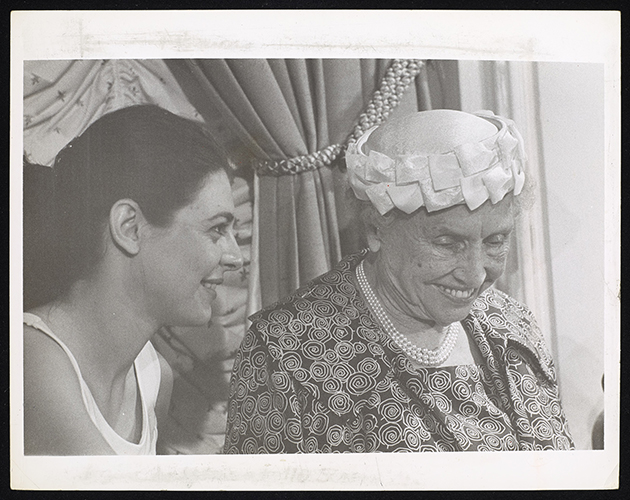
I thought I knew what I would find when I started my tenure as the Metadata Specialist for the digitization project of the Helen Keller Archive.
During my graduate school internship at the Perkins School for the Blind in Watertown, MA, I processed several collections relating to the education and history of those who are blind and visually impaired. I knew all of the major Massachusetts players: Samuel Gridley Howe, Laura Bridgman, Edward Waterhouse, Dr. Edward Allen, Arthur Gilman, Michael Anagnos, etc. I knew what a braille writer looked like, how education for those with vision loss started in Europe and the United States, and all of the different tactile forms of communication throughout the years. Helen Keller’s life couldn’t be that different, right? Wrong. Most of my knowledge on the history of blindness took place before Helen was even born.
From the first digital folder I viewed, I knew that I would need to bring my knowledge into the 20th century. I learned that this new knowledge would be on more than just history and Helen’s biography, but on the world as a whole. I could not imagine that I would be forced to look up when Puerto Rico was acquired by the United States (1917—right in the middle of Anne Sullivan’s visit), or the first prison to house Eugene V. Debs (West Virginia State Prison—Debs’ serial #2253). When did Ceylon became Sri Lanka? Who was the President of the YWCA in Cairo? What country is Bulawayo in now? Who were the major political players in the United States in the 1950s?
My research went beyond the English language. I had to learn how to identify all the major world languages by sight. I even had lists near my desk of how to say “deaf,” “deafblind,” and “mute” in various translations. I had to have Helen’s entire family tree for at least six generations on hand at all times and even found myself writing out Mark Twain’s family tree for at least four generations. I could honestly go on for pages about all of the information I had to look up and store in my brain while working on this collection. I haven’t even mentioned deciphering thousands of handwriting styles (I’m looking at you, Polly Thomson).
Therefore, it is safe to say that this collection is far more than just information about Helen’s life and work and more of a history of the world. Every major world event that took place during Helen’s life is somewhere in this collection—wars, union strikes, political elections, women’s suffrage, race relations. Helen either wrote about—or someone wrote to her—about all of it. If Helen didn’t write about it, it’s still in the collection as a newspaper article published next to one of her pieces, a postcard from a long-forgotten museum, or a ballet performed in her honor. Theatre, dance, movies, vaudeville, music, opera, sculpture, portraiture, literature—all forms of art are on display in this collection and all were beloved by Helen. Helen has become a part of my life and the lives of the many who have worked on this archive. We are on a first name basis with her. We refer to her as Helen and we think of her as Helen because she has become ours. Looking up the myriad of facts above was not done begrudgingly—we wanted to make sure the collection was as accurate and whole as possible. After all, our hard work was not in vain; because at the end of it all, we got to know an extraordinary woman.